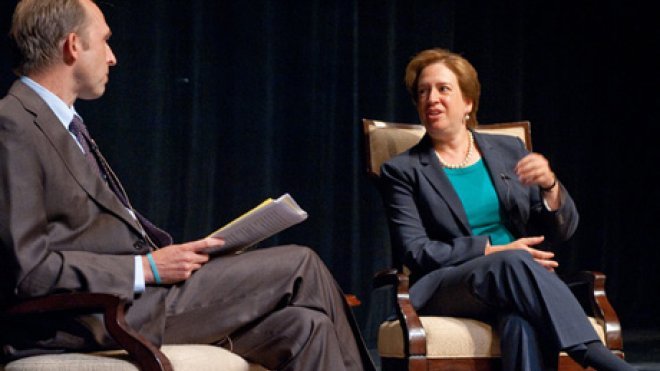From Justice Kagan, a Glimpse at Life on the Supreme Court
For first-year students at RWU Law, Kagan’s visit meant an insider’s perspective
on the Supreme Court in their first days of law school

Providence, R.I. –Justice Elena Kagan of the U.S Supreme Court talked about digital technology, religious tolerance and women in the law in a wide-ranging conversation sponsored by Roger Williams University School of Law and hosted by Rhode Island Gov. Lincoln Chafee, who introduced the event.
Justice Kagan – who was in Rhode Island to celebrate the 350th anniversary of the state’s 1663 Colonial Charter and the 250th anniversary of the Touro Synagogue in Newport – spent Tuesday morning speaking to several hundred citizens, judges, law professors, lawyers and law students (including RWU Law’s entire 2013 entering class) on a wide array of topics, both light and profound. She was interviewed by Ted Widmer, a historian and librarian at Brown University who has served as a speechwriter for the Clintons.
“Our entire incoming class attended as part of its law school orientation, an opportunity likely unmatched at any other law school,” said Roger Williams University School of Law Dean David A. Logan. “Our students have had a chance to interact with eight of the nine members of the current Court, and later this fall RWU Law will be graced by a visit from Sandra Day O'Connor, the first woman to serve on the nation’s highest court.”
The message was not lost on members of the new class. “She inspired me,” said Portia Essuman, a first-year law student from Ghana. “I was particularly impressed by her words about writing decisions clearly, so that not just lawyers but ordinary people can understand what is being said.”
“I’ve met Justice [Samuel] Alito and Justice [Stephen] Breyer during my time at RWU Law, but this was the first woman justice for me,” said Valerie León, a third-year student serving as an usher at the event. “I liked Justice Kagan’s thoughts on the expanding role of women in the law. And I am really looking forward to seeing Justice [Sandra Day] O’Connor in October. Even though we’re a small law school, we’re the only one in Rhode Island and these high-profile visits help show our importance and impact.”
Kagan opened her remarks by referencing a “profound and surprising” letter written by President George Washington to the Touro Synagogue in 1790, and finessing the difference between religious tolerance – which implies “good faith” and “indulgence” – and the “much larger” right of religious freedom. She added that while “Judaism is an important part of my life and self-identity,” it did not affect her relationship to the law.
She noted that she currently sat in the seat that once belonged to Justice Louis Brandeis, the Court’s first Jewish member, and “one of my judicial heroes.” Discussing the long-term power of Supreme Court dissents, she referenced Brandeis’s 1928 dissent in Olmstead v. United States, in which he warned that technology would empower the government with the ability to trespass and invade privacy in subtle ways. “Boy, did he get that right,” she said, noting that at the time, it must have read like science fiction.
Despite Brandeis’s prescience, Kagan added, the Court itself tends to be digitally behind the times. “E-mail is already old-fashioned, and the Court hasn’t gotten to that yet.” She added that the justices are helped “a little bit” by their young clerks in understanding social media and other technological developments.
Still, she insisted, the Court is not an ivory tower. “It wouldn’t be a great thing if we were determined to be cloistered and not have any idea of what’s going on in the world out there.”
Kagan reflected on her experiences in the 1980s as a law clerk to Supreme Court Justice Thurgood Marshall, whom she called “the best storyteller I’ve ever met” and “the best lawyer of the 20th century.”
She added that, despite the infamous liberal/conservative split that so often produces news-making 5-4 decisions – she and her colleagues on the Court get on famously. “When you read our opinions and dissents, you think ‘These people must hate each other!’ But this is a very genial Court. We have a lot of respect for each other.” She added, “everybody’s trying to get this right,” though they admittedly have “very different ideas of what’s right.”
As only the fourth female justice of the Court, Kagan said that – while she and her colleague Justice Sonia Sotomayor “stand on the shoulders” of female legal pioneers of the previous generation, such as Justice Ruth Bader Ginsburg and former Justice Sandra Day O’Connor – there is no “women’s bloc” on the Court.
Commenting on the “colloquial” writing style in her legal opinions, she explained that she likes to “speak in a language everyone understands.” Dialing back the legalese also “allows a little room for your own personal voice to show through.”
Kagan, 53, was appointed to the court in 2010 by President Barack Obama. She previously served as solicitor general of the United States and dean of Harvard Law School, among many other accomplishments. She is the youngest justice and the one most recently appointed to the court. The Honorable Bruce Marshall Selya of the U.S. Court of Appeals for the First Circuit facilitated Kagan’s visit.